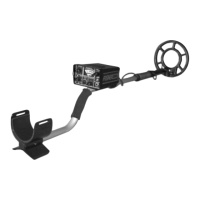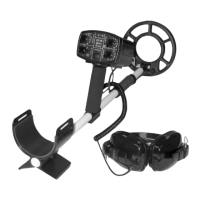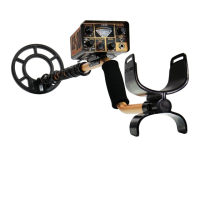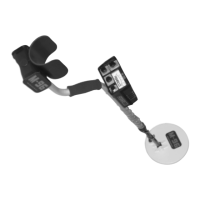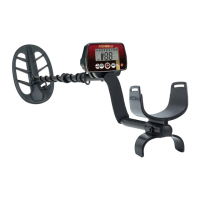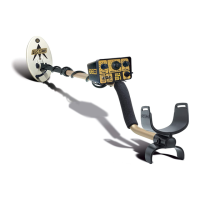14
GROUND BALANCING
4. With a little practice, you should be able to ground
balance quickly by “bobbing” the coil up and
down in a continuous movement as you adjust the
GROUND control with your thumb.
NOTES:
1. If you get an audio response as you first lower the coil with
the GROUND control at 10, you’re probably over a piece
of metal. Move and try again.
2. lf you get a sudden bell tone, not preceded by an increasing
audio response, you’re probably in some very highly
mineralized soil or sand. Instead of lowering the coil to an
inch or two above the ground (as in step 2 above), stop just
before you hear the bell tone and ground balance as
instructed. Maintain that coil height as you search.
3. If you don’t get an audio response, or if the hum stays the
same no matter where you set the GROUND controls as you
bob the coil up and down, you’re probably in an area
where there’s very little ground mineralization. Just leave
the GROUND control at “10” and begin searching.
4. Recheck your ground balance occasionally.
27
TARGET RECOVERY
Once you’ve identified and pinpointed a target, your
objective is to recover it quickly and neatly, leaving virtually no
trace of your excavation. There are almost as many ways to do
this as there are treasure hunters. Whatever works for you is good
enough as long as you don’t break any laws, leave uncovered
holes or damage the environment either on land or underwater.
Generally speaking, divers and beachcombers do little, if any,
damage to the environment while recovering small targets.
However, if you plan to use your CZ-20 on lawns or in parks, your
target-recovery method can be very important. Two of the most
successful methods are illustrated in a separate booklet enclosed
with your CZ-20.
1. When in doubt, dig. If your CZ-20 can’t quite decide
whether a target is good or bad, dig it up.
2. Good things often come in two’s. Or even three’s.
Once you’ve recovered a good target, always
recheck the hole for a second signal and carefully
search the immediate area by walking slowly
around the hole two or three times, overlapping
your sweeps in an ever-widening circle. Always dig
every suspicious sound in the vicinity of a good find.
3. Recheck your hole even if your find was trash.
Good targets are often found beneath bad ones.
Whichever method you choose, remember that responsible
treasure hunters take pride in their ability to leave soil and
vegetation intact and undamaged. If you don’t want to see your
right to treasure hunt restricted or even eliminated by
government legislation, fill those holes and leave your hunting
areas in better shape than when you arrived!
